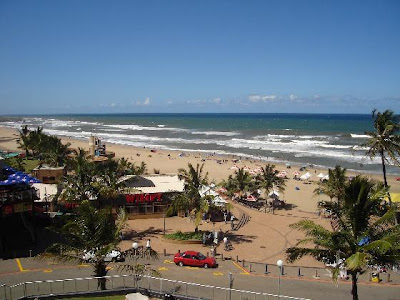A national coat of arms, or State emblem, is the highest visual symbol of the State.
The coat of arms is also a central part of the Great Seal, traditionally considered to be the highest emblem of the State. Absolute authority is given to every document with an impression of the Great Seal on it, as this means that it has been approved by the President of South Africa.
The Coat of Arms is a series of elements organised in distinct symmetric egg-like or oval shapes placed on top of one another:
The lower oval shape represents the elements of Foundation:
- The first element is the Motto, in a green semicircle. Completing the semicircle are two symmetrically placed pairs of elephant tusks pointing upwards. Within the oval shape formed by the tusks are two symmetrical ears of wheat, that in turn frame a centrally placed gold shield.
- The shape of the shield makes reference to the drum, and contains two human figures from Khoisan rock art. The figures are depicted facing one another in greeting and in unity.
- Above the shield are placed a spear and a knobkierie, crossed in a single unit. These elements are arranged harmoniously to give focus to the shield and complete the lower oval shape of foundation.
The oval shape of Ascendance:
- Immediately above the oval shape of foundation, is the visual centre of the Coat of Arms, a protea. The petals of the protea are rendered in a triangular pattern reminiscent of the crafts of Africa.
- The secretary bird is placed above the protea and the flower forms the chest of the bird. The secretary bird stands with its wings uplifted in a regal and uprising gesture. The distinctive head feathers of the secretary bird crown a strong and vigilant head.
- The rising sun above the horizon is placed between the wings of the secretary bird and completes the oval shape of ascendance.
- The combination of the upper and lower oval shapes intersect to form an unbroken infinite course, and the great harmony between the basic elements result in a dynamic, elegant and thoroughly distinctive design. Yet it clearly retains the stability, gravity and immediacy that a Coat of Arms demands.
What is it symbolizing?
The Motto
The motto is: !ke e: /xarra //ke, written in the Khoisan language of the /Xam people, literally meaning: diverse people unite. It addresses each individual effort to harness the unity between thought and action. On a collective scale it calls for the nation to unite in a common sense of belonging and national pride - Unity in Diversity.
The ears of wheat
An emblem of fertility, it also symbolises the idea of germination, growth and the feasible development of any potential. It relates to the nourishment of the people and signifies the agricultural aspects of the earth.
Elephant Tusks
Elephants symbolise wisdom, strength, moderation and eternity.
The shield
It has a dual function as a vehicle for the display of identity and of spiritual defence. It contains the primary symbol of our nation.
The human figures
The figures are derived from images on the Linton stone, a world famous example of South African Rock Art, now housed and displayed in the South African Museum in Cape Town. The Khoisan, the oldest known inhabitants of our land and most probably of the earth, testify to our common humanity and heritage as South Africans and as humanity in general. The figures are depicted in an attitude of greeting, symbolising unity. This also represents the beginning of the individual’s transformation into the greater sense of belonging to the nation and by extension, collective Humanity
The spear and knobkierie
Dual symbols of defence and authority, they in turn represent the powerful legs of the secretary bird. The spear and knobkierie are lying down, symbolising peace.
The protea
The protea is an emblem of the beauty of our land and the flowering of our potential as a nation in pursuit of the African Renaissance. The protea symbolises the holistic integration of forces that grows from the earth and are nurtured from above. The most popular colours of Africa have been assigned to the protea – green, gold, red and black.
The secretary bird
The secretary bird is characterised in flight, the natural consequence of growth and speed. It is the equivalent of the lion on earth. A powerful bird whose legs - depicted as the spear and knobkierie - serve it well in its hunt for snakes symbolising protection of the nation against its enemies. It is a messenger of the heavens and conducts its grace upon the earth, in this sense it is a symbol of divine majesty. Its uplifted wings are an emblem of the ascendance of our nation, whilst simultaneously offering us its protection. It is depicted in gold, which clearly symbolises its association with the sun and the highest power.
The rising sun
An emblem of brightness, splendour and the supreme principle of the nature of energy, it symbolises the promise of rebirth, the active faculties of reflection, knowledge, good judgement and willpower. It is the symbol of the source of life, of light and the ultimate wholeness of Humanity.
The completed structure of the Coat of Arms combines the lower and higher oval shape in a symbol of infinity. The path that connects the lower edge of the scroll, through the lines of the tusks, with the horizon above which the sun rises at the top, forms the shape of the cosmic egg from which the secretary bird rises. In the symbolic sense this is the implied rebirth of the spirit of our great and heroic nation.


















